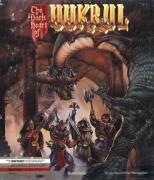Game Description
Developed by Digital Studios Limited and published by Brøderbund in early 1989, The Dark Heart of Uukrul is an excellent CRPG that effectively brings together many well-regarded elements used in other fantasy games from the same era, a fistful of its own unique features, and an assortment of puzzles that will test even the most formidable dungeon thinkers. The game is devoid of any music and sound effects and the character creation system leaves something to be desired, but even with these small issues, its many other assets elevate it to the much-deserved Hall of Fame status we've given it here on GameBanshee.
In the game, the player controls a party composed of four specific characters (or Aspirants, as the game calls them) - a warrior, a paladin, a priest, and a magician. The only choices presented during character creation are in regard to gender, race, and starting attributes, the last of which are determined by a handful of situational questions. The player will be making more difficult choices later on (like sub-class specializations), but the lack of early character options ensures that you're able to jump into the game quickly. Once the party is formed, you're immediately dropped into a hallway within the mountain city of Eriosthé, and it's this maze-filled underground expanse that you'll spend the entirety of the game.
To summarize the storyline, you've been sent to Eriosthé by a council of your superiors in order to locate and destroy an ancient evil named Uukrul. Uukrul defeated the Ancients that once resided here, and the council suspects that the last contingent of soldiers they sent (led by a sorceress named Mara) has met the same fate. Vanquishing him won't be easy, however, as Uukrul has literally torn out his own heart and hidden it deep within the mountain city. And since the absence of a heart keeps his physical body detached from the material plane, you'll have to find it before ever confronting him. So it goes.
Navigating the halls of Eriosthé is done through a first-person perspective that's nearly identical to what was used in other popular titles at the time, namely The Bard's Tale and Wizardry series. Where it differs greatly is in the story-telling - many of the squares you move to will prompt a paragraph or three describing your surroundings and/or what one of your four party members notices about the area, Dungeon Master-style. At times, you can interact with objects mentioned in the text (you'll do this a lot to solve puzzles), or are at least urged to take some kind of action in response to the description (listen at a door, search for secret doors, prepare for a major battle, etc.). Monster encounters occur randomly as you travel, and periodically you'll be able to take refuge in sanctuaries (each one representing a greater distance into the city) or at the marketplace, where you can buy/sell items, resurrect any dead characters, or recruit new party members to fill the role of a fallen character who has been dead beyond the resurrection time limit. To keep players from getting lost, the game features an excellent auto-map system.
The game's turn-based combat feels very much like the system devised by SSI for the Wizard's Crown and Gold Box series. When a group of monsters have been stumbled upon, the game shifts to an overhead viewpoint, and each of the participants are allowed to move one square and execute roughly one action each turn. The warrior will typically strike or parry attacks, the paladin will either attack, parry, or use his or her Lay on Hands ability, the priest can choose to use melee, invoke a prayer, turn undead, or call an elemental, and the wizard will more-often-than-not cast a spell from his arsenal. There are 20 different prayers that can be invoked across four divine gods, while wizards can choose from 60 spells across five "Arkanas of Knowledge". Each one is manifested using the specific abbreviation from the manual (just as we did in The Bard's Tale), which equates to an extra measure of copy protection alongside the game's printed Soul Amulets (which are in turn used to access the various sanctuaries).




